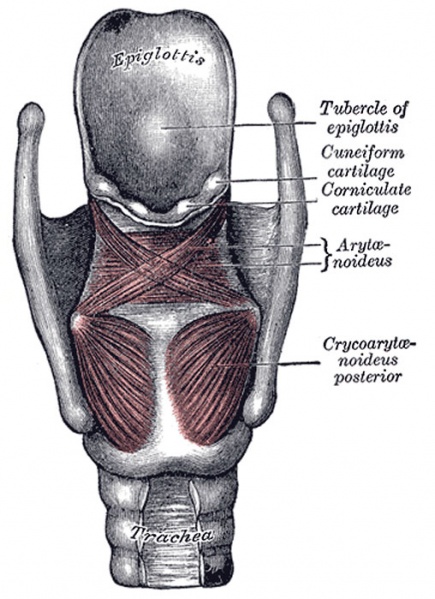File:Gray0958.jpg

Original file (508 × 700 pixels, file size: 85 KB, MIME type: image/jpeg)
Larynx Muscles
Posterior view.
The Cricoarytænoideus posterior (posterior cricoarytenoid) (Fig. 958) arises from the broad depression on the corresponding half of the posterior surface of the lamina of the cricoid cartilage; its fibers run upward and lateralward, and converge to be inserted into the back of the muscular process of the arytenoid cartilage. The uppermost fibers are nearly horizontal, the middle oblique, and the lowest almost vertical.
The Arytænoideus (Fig. 958) is a single muscle, filling up the posterior concave surfaces of the arytenoid cartilages. It arises from the posterior surface and lateral border of one arytenoid cartilage, and is inserted into the corresponding parts of the opposite cartilage. It consists of oblique and transverse parts. The Arytænoideus obliquus, the more superficial, forms two fasciculi, which pass from the base of one cartilage to the apex of the opposite one, and therefore cross each other like the limbs of the letter X; a few fibers are continued around the lateral margin of the cartilage, and are prolonged into the aryepiglottic fold; they are sometimes described as a separate muscle, the Aryepiglotticus. The Arytænoideus transversus crosses transversely between the two cartilages.
(Text modified from Gray's 1918 Anatomy)
- Larynx Image Links: All cartilages of the larynx | Epiglottis cartilage | Thyroid cartilage | Cricoid cartilage | Arytenoid cartilage | Larynx ligaments anterior | Larynx ligaments posterior | Larynx sagittal section | Larynx and upper trachea | Larynx entrance | Larynx interior | Larynx muscular attachments | Larynx muscles 1 | Larynx muscles 2 | Larynx muscles 3 | Cartilage Development | Respiratory System Development
- Gray's Images: Development | Lymphatic | Neural | Vision | Hearing | Somatosensory | Integumentary | Respiratory | Gastrointestinal | Urogenital | Endocrine | Surface Anatomy | iBook | Historic Disclaimer
| Historic Disclaimer - information about historic embryology pages |
|---|
| Pages where the terms "Historic" (textbooks, papers, people, recommendations) appear on this site, and sections within pages where this disclaimer appears, indicate that the content and scientific understanding are specific to the time of publication. This means that while some scientific descriptions are still accurate, the terminology and interpretation of the developmental mechanisms reflect the understanding at the time of original publication and those of the preceding periods, these terms, interpretations and recommendations may not reflect our current scientific understanding. (More? Embryology History | Historic Embryology Papers) |
| iBook - Gray's Embryology | |
|---|---|

|
|
Reference
Gray H. Anatomy of the human body. (1918) Philadelphia: Lea & Febiger.
Cite this page: Hill, M.A. (2024, April 27) Embryology Gray0958.jpg. Retrieved from https://embryology.med.unsw.edu.au/embryology/index.php/File:Gray0958.jpg
- © Dr Mark Hill 2024, UNSW Embryology ISBN: 978 0 7334 2609 4 - UNSW CRICOS Provider Code No. 00098G
File history
Click on a date/time to view the file as it appeared at that time.
| Date/Time | Thumbnail | Dimensions | User | Comment | |
|---|---|---|---|---|---|
| current | 18:38, 21 August 2012 |  | 508 × 700 (85 KB) | Z8600021 (talk | contribs) | ==Muscles of Larynx== Posterior view. The Cricoarytænoideus posterior (posterior cricoarytenoid) (Fig. 958) arises from the broad depression on the corresponding half of the posterior surface of the lamina of the cricoid cartilage; its fibers run upwar |
You cannot overwrite this file.
File usage
The following 4 pages use this file:
